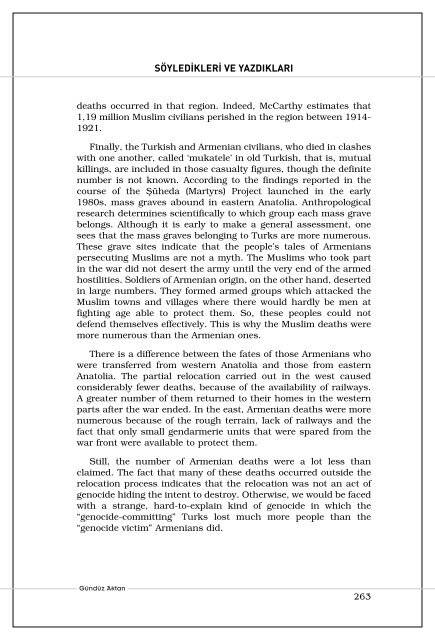gunduz-aktan-kitap-soyledikleri-ve-yazdiklari
gunduz-aktan-kitap-soyledikleri-ve-yazdiklari
gunduz-aktan-kitap-soyledikleri-ve-yazdiklari
Create successful ePaper yourself
Turn your PDF publications into a flip-book with our unique Google optimized e-Paper software.
SÖYLEDİKLERİ VE YAZDIKLARI<br />
deaths occurred in that region. Indeed, McCarthy estimates that<br />
1,19 million Muslim civilians perished in the region between 1914-<br />
1921.<br />
Finally, the Turkish and Armenian civilians, who died in clashes<br />
with one another, called ‘mukatele’ in old Turkish, that is, mutual<br />
killings, are included in those casualty figures, though the definite<br />
number is not known. According to the findings reported in the<br />
course of the Şüheda (Martyrs) Project launched in the early<br />
1980s, mass gra<strong>ve</strong>s abound in eastern Anatolia. Anthropological<br />
research determines scientifically to which group each mass gra<strong>ve</strong><br />
belongs. Although it is early to make a general assessment, one<br />
sees that the mass gra<strong>ve</strong>s belonging to Turks are more numerous.<br />
These gra<strong>ve</strong> sites indicate that the people’s tales of Armenians<br />
persecuting Muslims are not a myth. The Muslims who took part<br />
in the war did not desert the army until the <strong>ve</strong>ry end of the armed<br />
hostilities. Soldiers of Armenian origin, on the other hand, deserted<br />
in large numbers. They formed armed groups which attacked the<br />
Muslim towns and villages where there would hardly be men at<br />
fighting age able to protect them. So, these peoples could not<br />
defend themsel<strong>ve</strong>s effecti<strong>ve</strong>ly. This is why the Muslim deaths were<br />
more numerous than the Armenian ones.<br />
There is a difference between the fates of those Armenians who<br />
were transferred from western Anatolia and those from eastern<br />
Anatolia. The partial relocation carried out in the west caused<br />
considerably fewer deaths, because of the availability of railways.<br />
A greater number of them returned to their homes in the western<br />
parts after the war ended. In the east, Armenian deaths were more<br />
numerous because of the rough terrain, lack of railways and the<br />
fact that only small gendarmerie units that were spared from the<br />
war front were available to protect them.<br />
Still, the number of Armenian deaths were a lot less than<br />
claimed. The fact that many of these deaths occurred outside the<br />
relocation process indicates that the relocation was not an act of<br />
genocide hiding the intent to destroy. Otherwise, we would be faced<br />
with a strange, hard-to-explain kind of genocide in which the<br />
“genocide-committing” Turks lost much more people than the<br />
“genocide victim” Armenians did.<br />
Gündüz Aktan<br />
263



